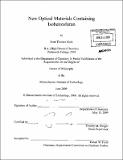New optical materials containing isobenzofuran
Author(s)
Meek, Scott Thomas
DownloadFull printable version (35.21Mb)
Other Contributors
Massachusetts Institute of Technology. Dept. of Chemistry.
Advisor
Timothy M. Swager.
Terms of use
Metadata
Show full item recordAbstract
Isobenzofuran, a member of the benzo[c]heterocycles, is an extremely reactive molecule with unusual electronic properties. In this thesis we investigate the integration of isobenzofuran subunits into conjugated optical materials. We discuss the properties of isobenzofuran, its role in organic chemistry, and the synthesis of isobenzofuran containing materials in the context of the other well known benzo[c]heterocycle, isothianaphthene. Isothianaphthene has been used in conducting polymers and organic fluorophores as a proquinoid unit, and we posit that isobenzofuran, due to its intrinsic instability, would display greater proquinoid character. To study this effect, we developed a synthetic route to integrate isobenzofuran into near-infrared donor-acceptor type fluorophores. These dyes, the IBF-NIADs, exhibit red-shifted absorption and emission over corresponding isothianaphthene containing dyes, thus highlighting the effective proquinoid nature of isobenzofuran. With the fundamentals of the IBF-NIAD dyes developed, we then expanded the series into a library of fluorophores for near-infrared fluorescence imaging application. Due to low absorption, autofluorescence, and scattering in the near-infrared region, near-infrared fluorescence imaging has the potential to provide non-invasive diagnostic techniques. In particular, our interest lay in imaging P-amyloid plaques, a hallmark pathology of Alzheimer's disease. (cont.) We tailored our dye series by modifying the conjugated backbone and the electron-donating group in order to optimize their photophysical properties, minimize their aggregation in aqueous solution, and maximize their optical response on binding to P-amyloid fibrils. Through these efforts we developed several fluorophores that exhibit large bathochromic shifts on binding, with concomitant increases in fluorescence intensity and lifetime, and absorption and emission spectra that extend well into the near-infrared. With the Backskai group at MGH, we found that most of these dyes stain P-amyloid plaques in transgenic APP/PS 1 mouse brain tissue, and efforts are underway to test their in vivo imaging potential. Finally, we present our initial synthetic work in integrating isobenzofuran into donor-acceptor-donor oligomers for nonlinear optical applications.
Description
Thesis (Ph. D.)--Massachusetts Institute of Technology, Dept. of Chemistry, 2009. Includes bibliographical references.
Date issued
2009Department
Massachusetts Institute of Technology. Department of ChemistryPublisher
Massachusetts Institute of Technology
Keywords
Chemistry.